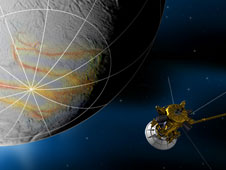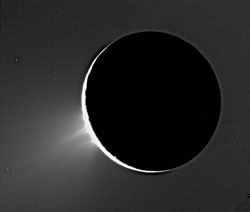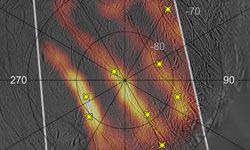 John Spencer
John Spencer
Cassini Scientist on the Composite Infrared Spectrometer (bio)
Our next Enceladus encounter is very soon, at 21:06 Universal Time or 14:06pm Pacific time. This promises to be a spectacular encounter, giving our first high-resolution sunlit view of the south polar region since the discovery of activity there three years ago (the most recent encounter, in March 2008, observed the south pole only in the darkness of Saturn’s shadow). Our instrument, the Composite Infrared Spectrometer (CIRS), will be mapping the heat radiation from the warm tiger stripes as we did in last March’s flyby, but on that flyby our best views were from a range of 14,000 km (8,500 miles), allowing us to see details of the heat radiation on scales as small as 4 km (2.5 miles). This time we’ll start our observations from a range as close as 900 km (560 miles), showing us Enceladus in fabulous close-up, with CIRS mapping details as small as 270 meters (0.17 miles). As we scan the south pole we’re screaming away from Enceladus at nearly 18 kilometers/second (40,000 mph) so we have to work fast to make the most of this high-resolution opportunity.
 Image left: Heat radiation from tiger stripes. Full caption
Image left: Heat radiation from tiger stripes. Full caption
I’m most excited about the observation we’ll be attempting at about 21:11 UT, when we will try to put the CIRS short-wavelength detector right along one of the most active tiger stripes, called Damascus Sulcus, from a distance of only 4,500 km (2,800 miles). On our last flyby we saw temperatures as high as at least 180 Kelvin (-135 Fahrenheit) on this part of Damascus, from 15,000 km (9,000 mile) range, and from three times closer we might see even higher temperatures because the warm material, which we think occupies a strip just tens or hundreds of meters wide along the fractures, will fill more of our detector and give us a more accurate reading. However, this is a challenging observation because our detector consists of a linear array of ten pixels, which will be aligned parallel to the fracture. Pointing may not be perfect this close to the moon, so we may get all ten detectors, or none of them, on Damascus. You might ask why we didn’t align the detector across the fracture rather than parallel to it, to be sure that at least some of our pixels would fall on the warm material. But we needed to align the spacecraft in the direction that allows it to rotate as fast as possible to keep up with Enceladus as we zoom past, and we didn’t have the luxury of also optimizing the orientation of the detector.
The animation to the right depicts Cassini flying close to Enceladus.
So tomorrow morning, when we hope the data will be processed and ready for us to look at, we’ll be both nervous and excited to see if this particular gamble paid off. But even if we are unlucky in this case, we’ll get lots of other spectacular data. Here’s a blow-by-blow account of the planned CIRS observations of the south pole, with times given in Universal Time (UT):
21:07-21:11 UT Very high resolution scan of the tiger stripes, riding along with the ISS camera “skeet shoot” observation that Amanda described in her previous blog entry, and ending with that view of Damascus Sulcus that I discussed above.
21:11-21:34 UT Ride along with the ISS camera mosaic of the south pole- more very valuable high-resolution views of selected locations on and near the tiger stripes.
21:36-21:50 UT A long-wavelength map of the entire southern hemisphere, which will allow us to measure total heat flow from the active south polar region. Enceladus enters Saturn’s shadow during this period, at 21:41.
21:52-22:09 UT A single scan of the south pole using our short-wavelength detectors, which will pick up the small part of the tiger stripes, along Alexandria Sulcus, that we missed in our March 2008 scan.
22:10-22:56 UT A global 7-16 micron map of the southern hemisphere with our short wavelength detectors, including the south pole, to look for changes in thermal emission since previous observations.
22:57-23:37 UT A stare at Damascus Sulcus with each of our two short-wavelength detectors, to give other instruments a chance to watch Enceladus in eclipse.
23:37-23:55 UT A maneuver to change the spacecraft orientation.
23:55-00:24 UT Watch the warming of Enceladus as it emerges from Saturn’s shadow at 00:07 UT, with the our long-wavelength detector.
00:25-00:42 UT ISS camera and VIMS compositional maps of the now-sunlit south pole.
00:42-01:04 UT Complete the CIRS long-wavelength observation of the post-eclipse warming.
It’s going to be one heck of a ride- I’ll report back once we’ve had a look at our data.
![]() Carolyn Porco
Carolyn Porco
 Image left: Heat radiation from tiger stripes.
Image left: Heat radiation from tiger stripes.  Todd Barber,
Todd Barber,  Speaking of propellant usage, there have been some questions about how
Speaking of propellant usage, there have been some questions about how 
 Carolyn Porco
Carolyn Porco 
 I will say what I said four years ago as we were first entering the Saturn system and about to begin our explorations of this mysterious and far-away place … a time that now seems like a lifetime ago: Prepare to be amazed!
I will say what I said four years ago as we were first entering the Saturn system and about to begin our explorations of this mysterious and far-away place … a time that now seems like a lifetime ago: Prepare to be amazed!  John Spencer, Cassini Scientist on the Composite Infrared Spectrometer (
John Spencer, Cassini Scientist on the Composite Infrared Spectrometer ( Linda Spilker, Cassini Deputy Project Scientist
Linda Spilker, Cassini Deputy Project Scientist  John Spencer, Cassini Scientist on the Composite Infrared Spectrometer (
John Spencer, Cassini Scientist on the Composite Infrared Spectrometer ( Amanda Hendrix, Cassini Scientist on the Ultraviolet Imaging Spectrograph
Amanda Hendrix, Cassini Scientist on the Ultraviolet Imaging Spectrograph  Linda Spilker, Cassini Deputy Project Scientist
Linda Spilker, Cassini Deputy Project Scientist